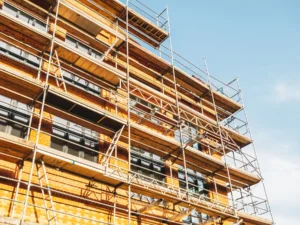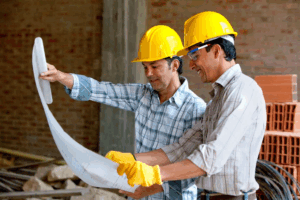
Scaffolding is a temporary structure that supports workers and materials in construction and maintenance. The scaffolding is designed to allow workers to work safely at various levels while maintaining their safety. There are many different scaffolding systems, all of which meet specific functional requirements and site conditions.
The type of scaffolding system chosen depends on the nature and scope of the project, the thermal load, and the environment. The advantages of each type are different, ranging from steel scaffoldings to single scaffoldings. Each is designed for a specific purpose. Understanding the different types will help you to complete tasks efficiently and safely in construction.
Table of Contents
Hanging Scaffolding
Suspended scaffolding is ideal for high-rise tasks. Platforms are suspended by ropes or chains from the top of an existing structure. The design of the scaffold allows for easy height adjustment, which makes it perfect for window cleaning or painting. Birmingham scaffolding firms offer suspended systems that are tailored to meet specific requirements.
This type of scaffolding is flexible, which makes it more convenient and efficient for workers in urban areas. Regular inspections of this scaffolding are essential to ensure safety and reliability. For projects requiring versatility and heights above ground level, suspended scaffolding is the best choice.
A single scaffolding
Single scaffolding is commonly used for brick masonry. It consists of a simple structure made up of ledgers, standards, and putlogs. Standard supports are vertical, ledgers run horizontally parallel to the structure, and putlogs attach the scaffolding to a wall.
This type is located close to the wall. It’s usually 1.2 meters. This scaffolding provides a stable platform that allows workers to reach different heights and complete tasks like laying bricks or putting up plaster. It is relatively easy to assemble and cost-effective, so it’s a good choice for smaller jobs. It is designed for jobs that don’t require heavy-duty supports or long reach.
Dual Scaffolds
Double scaffolding is used primarily in stone masonry, where walls can be difficult to penetrate. This system has two parallel rows of vertical supports that provide additional strength and stability. The putlogs are resting on the two rows, rather than being embedded into the wall. This allows for projects with hard surfaces.
Double scaffolding is designed to support heavier loads and can be used for large-scale construction. The additional row increases safety and durability while ensuring workers have reliable access. This type of scaffolding is often referred to by the name independent scaffolding. It’s used for projects that require significant strength and stability under challenging conditions.
Scaffolding using Cantilevers
Cantilever scaffolding, which is designed for situations in which ground support is not possible or is impractical, is supported by needles that extend out of a structure. This type of scaffolding is often used in projects that involve high elevations or difficult-to-reach locations. Scaffolding services in Coventry are used to meet these specific needs.
Cantilever scaffolding offers outstanding stability and minimizes interference with activities at ground level. This scaffolding is especially useful for projects that require access to areas above obstructions like roads or pathways. The practical design of this scaffolding ensures safety and adaptability even in complex construction scenarios.
Scaffolding made of steel.
Steel scaffolding is a great choice for large construction projects because of its strength, durability, and adaptability. This type is made of steel tubes that are joined together by couplers. It can support heavy loads and ensure worker safety. Steel scaffolding has a high resistance to environmental factors such as fire and weather.
This increases its durability and reliability. Modular design allows quick assembly and disassembly, saving time. The investment in this type is worth it because of its durability and performance. Steel scaffolding can be used for projects that require robust structures with heavy-duty supports. This ensures consistency in efficiency during construction activities.
Take-away
It is important to know the differences between the types of scaffolding to choose the best one for your project. Steel and single-to steel scaffoldings have similar functional goals, such as safety measures to improve construction efficiency.
The choice is determined by the size of the project and the conditions at the site. Working with professionals, planning, and having good communication skills are all important for achieving the best results in construction.






